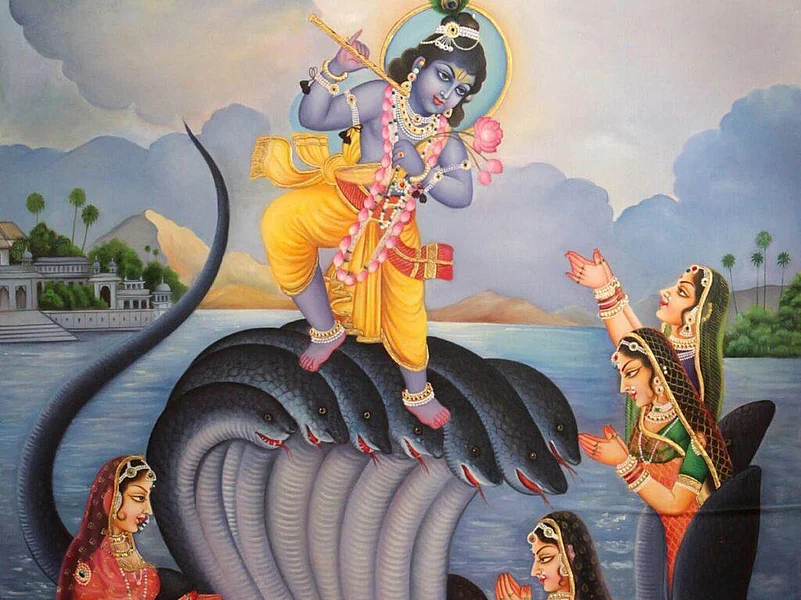Nag Panchami is a customary Hindu celebration observed in various regions of India. On this day, cobras and other snakes are revered through offerings of flowers, milk, and prayers. The celebration occurs in the monsoon period, on the fifth day of the waxing phase of the Shravan month. In 2025, Nag Panchami will take place on 29 July.
For many, the concept of venerating snakes might appear odd. In Indian culture, snakes are regarded as strong and sacred beings. Numerous tales and myths from historical writings illustrate the significance of this celebration. These tales have been handed down through generations and provide significance to the customs that individuals still observe today.
1. The Legend of Lord Krishna and Kaliya Naag
One of the most well-known stories connected to Nag Panchami comes from the life of Lord Krishna. As a young boy, Krishna was playing near the Yamuna River in Vrindavan when he heard that a poisonous snake named Kaliya had made the river dangerous. The water had turned dark, and many animals had died after drinking it.
Krishna decided to put an end to Kaliya’s terror. He jumped into the river and fought the snake. After a long battle, Krishna danced on Kaliya’s many heads and finally defeated him. Kaliya surrendered, and Krishna spared his life on the condition that he would leave the river and never return. This story is often told during Naag Panchami, reminding people of Krishna’s courage and his protection from evil.
2. The Story of King Janamejaya’s Snake Sacrifice
Another important story is that of King Janamejaya, the son of King Parikshit. According to the Mahabharata, King Parikshit was killed by a snake bite from a serpent named Takshaka. Angry and grieving, Janamejaya performed a massive yagna (sacrifice) to destroy all snakes and take revenge.
The fire ceremony was so powerful that snakes from all over the world were drawn into it and killed. However, the sacrifice was stopped when a wise sage named Astika arrived and convinced the king to end the ritual. Astika spoke about forgiveness, balance in nature, and the importance of all living beings. The day the yagna was stopped is said to be the day of Nag Panchami. Since then, snakes have been respected and worshipped on this day.
3. The Legend of the Farmer’s Family
A popular folk tale from rural India tells the story of a farmer who accidentally killed three baby snakes while ploughing his field. That night, the mother snake came to take revenge and bit the farmer and his family, causing their death. However, the farmer’s daughter was alive and deeply regretted what had happened.
The next day, she offered milk and prayers to the mother snake, asking for forgiveness and promising never to harm snakes again. Pleased by her devotion, the snake brought the family back to life. This story is often told in villages, reminding people to respect all creatures, even those they may fear.
4. Snakes in Hindu Mythology
Snakes are not just part of folk tales — they also appear in many important parts of Hindu mythology. Lord Shiva wears a snake around his neck, symbolizing control over fear and death. Lord Vishnu is shown resting on a serpent called Sheshnag, who floats on the cosmic ocean. These images show that snakes are not seen as evil but as powerful and protective beings.
In many traditions, snakes are believed to guard hidden treasures and sacred knowledge. They are also connected to the earth and water, which is why they are especially worshipped during the rainy season when snake sightings increase.
The legends behind Nag Panchami help explain why this festival is so meaningful in Indian culture. Whether it’s the story of Krishna defeating Kaliya, the message of forgiveness from Astika, or the farmer’s daughter seeking mercy, these tales teach us about courage, respect, and the balance of nature.
Nag Panchami might come off as an odd tradition on the surface, but when you get to know about the stories and reasoning behind these festivals, you understand these traditions are not beliefs but values. It is about living in harmony with all creatures, understanding the stories of our past, and honoring the traditions that bring people together, year after year.



























